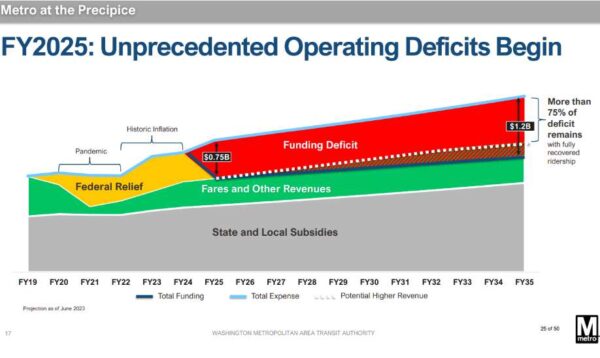
The price of riding on the Metro might go up and so could your tax bill.
Alexandria Mayor Justin Wilson said that the region will experience collective pain by bailing out the Washington Metropolitan Area Transit Authority from its projected $750 million budget deficit.
Wilson said there are no solutions that the city can afford to take off the table.
“We will have to determine ways to reduce the cost structure, the stakeholders will have to chip in and riders will likely bear some of the cost,” Wilson told ALXnow. “It’s going to involve some pain all around.”
WMATA gets billions annually from Alexandria, D.C., Maryland, other Northern Virginia jurisdictions and the federal government. Alexandria’s commitment this year is $56.6 million in operating dollars and $16.6 million in capital contributions.
“Following the exhaustion of federal relief funding in FY2024, Metro expects an operating deficit of $750 million in FY2025,” Metro announced in a budget presentation. “This is more than a one-year challenge. The deficit is projected to continue its growth through FY2035 even with continued ridership recovery.”
Metro Board Chair Paul C. Smedberg, a former member of the Alexandria City Council, said that the region needs a reliable transit system.
“Customers would see longer waits, constant gridlock, higher fares and reduced operating hours and the region’s economy could stagnate,” Smedberg said.
Without a funding increase from Alexandria and its neighbors, WMATA reported “unprecedented operating deficits” will force it to make drastic cuts to rail, bus, and paratransit services across the region.
“Balancing the budget with service cuts would require eliminating two-thirds of Metro’s existing service, with no service after 9:30 p.m.,” WMATA announced last month. “All but 37 of 135 bus lines would no longer operate, customers would wait 20-30 minutes for trains on all lines, and MetroAccess would serve a much smaller area with less hours.”

In his monthly newsletter, Wilson said a “reckoning is afoot” for the transit system now that federal subsidies have dried up and ridership is inching toward pre-pandemic levels.
As of May, Metrorail and Metrobus ridership was 50% and 88% of pre-pandemic levels, respectively, according to WMATA.
“Transit is essential to our region’s economy and our quality of life, but the financial model that has supported its existence for a generation is upside down,” Wilson wrote. “The work ahead requires defining a new model to sustain transit for another generation.”
Metro laid out these drivers for the $750 million deficit:
- Jurisdiction Subsidy Credit: At the onset of the pandemic, Metro provided support to jurisdictions in the form of a subsidy reduction and forgone three percent increases. Had Metro not provided this support, the jurisdictional subsidy would be $196 million higher in FY2025.
- Decreased revenue since the pandemic: Overall ridership is forecasted to be approximately 25 percent below pre-pandemic levels in FY2025. In addition, shorter distance and weekend trips, which result in less revenue than long distance weekday trips, have seen the fastest recovery. These changes and related impacts to parking and advertising revenues are expected to continue to keep revenue below pre-pandemic levels in the short and medium term. FY2025 total revenue is expected be approximately $288 million below pre-pandemic levels.
- Inflation and collective bargaining agreements: Historic inflation caused by the pandemic and related supply chain impacts made everything more expensive, raising Metro’s personnel and non-personnel costs. The vast majority of Metro’s workforce which operates and maintains the system participates in collective bargaining. Metro must comply with mandated annual increases under the terms of the respective collective bargaining agreements, which indexes compensation levels to inflation. This cost growth is responsible for $266 million.

